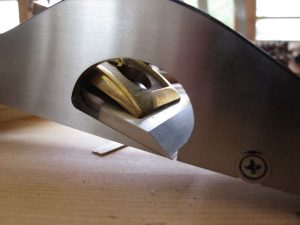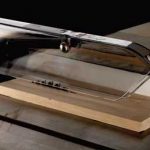We may receive a commission when you use our affiliate links. However, this does not impact our recommendations.
If you have attended any of the Lie-Nielsen Hand Tool Events in the last year and you have a sharp eye, then you probably noticed an odd-looking low-angle jack plane on one of the benches.
It’s much like the No. 62 that Lie-Nielsen has been making for many years, but its sidewalls are open so you can cut rabbets on either the left or right side of the tool. And it has cross-grain nickers.
This week I’m in Maine to do some teaching and film a DVD and I’m told the 610 is now in production and will be on the company’s web site shortly. The tool will cost $245, the same price as the No. 62. The body is 12-3/4” long with a 2-1/8”-wide blade.
I got to use a production version of the tool while teaching a class Saturday. Here are some first impressions.
The tool is nicely balanced and solid. My No. 1 concern with these sorts of tools is that the bed of the tool – the part that supports the iron – will flex under pressure from the lever cap. When this happens, the plane will cut in a seemingly unpredictable fashion because the sole has been made somewhat convex.
While I didn’t tighten the lever cap all the way, I over-tightened it well past the point of sanity, and the sole seemed fine.
The 610 is a specialty tool for furniture makers. It’s not going to replace your jack plane. But it does offer a set of features that might suit your work. Here are some of the form’s plusses and minuses.
On the plus side, the tool works quite well at making rabbets while working against a fence or batten. Its wide width would also make it an excellent tool for making the wide tenon on breadboard ends of a tabletop. The circular nickers are easy to extend from the body (retracting them quickly takes a little practice). And the long sole of the tool makes the resulting rabbet nice and true, even if the wood is not so flat.
For people who build workbenches or build timber-frames, this tool is like an awesome shoulder plane. Because of its open sidewalls it can clean up large cheeks and tenons. And the wide iron is going to improve your accuracy because you won’t have to take as many passes on a tenon.
Also, the wooden boatbuilders will probably dig this plane, just like they dig the bevel-down No. 10 bench rabbet plane.
On the downside, you give up a few features when you compare the tool to the regular No. 62. The 610 does not have an adjustable mouth. It’s a fixed mouth aperture and has an opening that is suited for rabbeting and general work. Also, you cannot use this tool on a shooting board because of its rabbeted sides – it will chew up your shooting board with every stroke.
As always with Lie-Nielsen tools, the quality, fit and finish of all the components was top shelf. The 610 works very well and is made well. You just have to decide if it belongs in your tool chest.
— Christopher Schwarz
Here are some supplies and tools we find essential in our everyday work around the shop. We may receive a commission from sales referred by our links; however, we have carefully selected these products for their usefulness and quality.












This is for Christopher Schwartz: I saw you once on youtube testing hand planes with a HAMMER no less, that was the most moronic test you can ever conduct on a plane, so, now I challenge you, Christopher to try your MORONIC test on the new LN 610 low angle rabbit plane, I wonder if you’re capable to break this one!
I’ve had mine for a few weeks now, and it’s certainly earned a spot next to my 62 when I’m traveling. My only regret is that they couldn’t magically use the same blades as the 62 so that you could swap all of the options. I knows it’s impossible, but can’t we all dream a bit?
I like mine just fine so far. Happy I bought it.
Mike
Hey Chris,
Thanks for the head’s up, I’ve been curious about how the 610 would work in practice since seeing it at WIA last year.
Just curious, what did you mean by “rabbeted sides” in regard to shooting? Did you mean the full width mouth/blade?
Niels